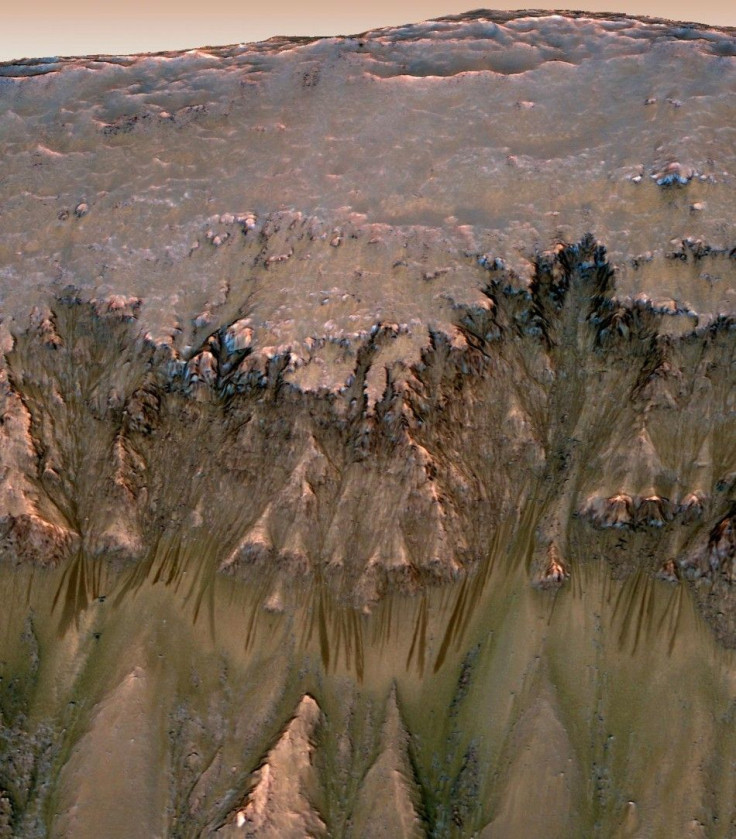Does Flowing Salty Water Sustain Life Beneath Mars Surface?

Can life exist on Mars? The latest discovery of new evidence of liquid water on the red planet once again brings up a ray of hope.
NASA scientists said on Thursday that new evidence indicates that highly salty water may flow on Mars during its summer, which also empowers the possibility of life on the planet.
Signs of water on the red planet were found over a decade ago, but the earlier findings indicated that any water on Mars would be in the form of ice and concentrated at both the poles. The reason behind the thought that life could be possible in Mars is that compared to ice, liquid water is more likely to sustain life, a fact that stresses the significance of the latest discovery.
"It is our first chance to see an environment on Mars that might allow for the expression of an active biological process, if there is present-day life on Mars," said Lisa Pratt, biogeochemist at Indiana University, Bloomington. Pratt was one of the participants on the NASA panel discussing the results on Thursday.
According to Pratt, Earth is the home for some organisms that live underground with almost no access to sunlight. Given the evidence of liquid salty water beneath Mars' surface, there is possibility of thriving life down there also, she said.
NASA's Mars Reconnaissance Orbiter satellite has obtained new images of the planet's surface that show evidence of flowing water during its late spring through summer in the form dark, finger-like features seen on some Martian slopes and cater walls. The narrow flow-lines are nowhere near the size of major rivers on Earth. They are about 0.5 to 5 yards, or meters, wide.
Scientists have confirmed seven sites with possible liquid flows on the red planet. There could be 20 to 30 sites more with similar flows.
"The best explanation for these observations so far is the flow of briny water," said Alfred McEwen of the University of Arizona, Tucson. McEwen is the principal investigator for the orbiter's High Resolution Imaging Science Experiment (HiRISE). McEwen is also the lead author of the report that published in Thursday's edition of the journal Science.
Explaining why the water on Mars would not congeal even in the planet's cold temperatures, scientists said that the possible liquid water on the planet would be extremely salty and lie under the surface. Temperature on Mars can go down to around 200 degrees below zero Fahrenheit (minus 128 degrees Celsius), scientists said.
According to scientists, the extremely thin atmosphere on Mars could make liquid water above ground evaporate quickly. That's why scientists believe that any water on the planet would lie beneath the surface.
Earlier NASA discoveries revealed evidence of olden shorelines and riverbanks on Mars, but further analysis of the discoveries couldn't provide definite proof of water flows.
Back in 2006, scientist discovered significant changes in several crater gullies. They reported that water was flowing under Mars' surface perhaps in the form of "flash floods". But, as it was supposed to have taken place during the winter, leaving very less chance for water to be liquid, following research has cast substantial doubt on that explanation. According to the current view, it was frozen carbon dioxide that might have been flooding.
In 2008, frozen water was uncovered below the Martian surface by NASA's Phoenix lander.
"The latest discovery is more difficult to explain away as evidence of anything but contemporary water flows," Reuters quoted Michael Meyer, Mars exploration program lead scientist at NASA, as saying.
"What makes these new observations so interesting is they occur at much lower latitudes [closer to the equator], where temperatures are much warmer and where it's actually possible for liquid water to exist," said Arizona State University geophysicist Phil Christensen, one of the scientists who studied the images beamed back from the orbiter.
However, there are contradictory views as well.
According to Dr David Leverington, of Texas Tech University, the planet's gullies were not shaped by water flows; instead they were created by low-viscosity lavas as seen in similar channel-like features on the moon and Venus, Dailymail reported.
Most experts deny Leverington's lava theory saying that the gullies were created by a volume of water, which was even greater than the largest river on Earth.
Leverington then replies back asking, "How do you get that volume of water? How do you move it quickly enough to rush out at a rate to carve channels like these?"
"He's (Leverington) reasoning on the features of the moon and Venus when we don't know the causes of those features either," Victor Baker, of the University of Arizona's Lunar and Planetary Laboratory, told Inside Science.
MUST READ: Post-shuttle Space Projects: Will Robotic Probes Replace Expensive Human Spaceflights?
© Copyright IBTimes 2024. All rights reserved.






















